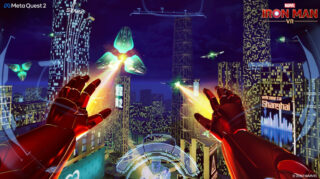Here’s how it looks, if you’re curious pic.twitter.com/AruCxNDPmF
— Chris Scullion (@scully1888) February 28, 2023
Review: Iron Man VR is a Stark improvement on Quest 2
In a hardware sense, the Quest 2 is certainly the best way to play Iron Man VR
- Game Director
- Ryan Payton
- Key Credits
- Brendan Murphy (Writer), Kazuma Jinnouchi (Composer)

Seattle-based Camouflaj’s virtual reality take on one of Marvel’s most popular heroes is a couple of years old now.
Iron Man VR was released on PlayStation VR back in July 2020, and was met with middling reviews due more to the limitations of the hardware – lengthy loading times and a 360-degree experience that didn’t really suit the headset’s PS Camera tracking (not to mention its spaghetti-like cables).
In true Tony Stark fashion, the game has now flown under the radar and landed on the Quest 2, and while some gameplay issues remain, those technical ones have been mostly Thanos-snapped out of existence.
The game is set five years after Stark first publicly revealed he was Iron Man, and he’s finally decided it’s time to hang up his suit and turn Stark Industries into a carbon-free, weapons-free company led by his former assistant Pepper Potts.
That doesn’t sit well, however, with Ghost, a mysterious hacker who wants to punish Stark for all the deaths caused by his company’s weapons over the years. And what better way to do that than to hack into a number of deactivated Stark combat drones and use them to attack Stark’s various global assets?
Stepping into the expensive shoes of Stark himself, it’s up to the player to dig out his heavy artillery one more time and put an end to Ghost’s quest for revenge (even if, let’s face it, it’s probably a valid one).
Visually, Iron Man VR is one of the most impressively detailed games we’ve seen on the Quest 2. It may technically be a slight visual downgrade from the PlayStation VR version – that’s what happens when you don’t have an external PS4 handling things – but the difference is negligible.
It’s how the game controls that may be the sticking point for some players, because it’s a bit too complicated for its own good. Players fly around by pointing their palms face down in the opposite direction to where they want to go, then pull the triggers to fire the boosters.
This may sound confusing but it makes sense: if you want to fly straight up, point your palms down and boost, and if you want to fly forwards you swing your arms back, point behind you and boost. It does feel natural when playing.
It’s when the other weapons come into play that things can get a bit convoluted. Some are mounted on Iron Man’s wrist and require the player to point their controls in the standard way many VR shooting gallery games do, while others are on his palms and therefore require the player to bring their palms up and fire that way.
Neither individual method works particularly badly, but when you have to switch between flying and using the different firing methods (not to mention a separate punching motion for ground-pounds) it can all feel a bit like patting your head and rubbing your tummy, and even five or six hours in it still hadn’t really felt second nature.
Also underwhelming is the lack of variety in the game. While the voice acting is generally of a high standard and the story’s engaging enough, some locations repeat themselves over the course of the game and the number of enemy types is disappointingly low.
It all means that by the time you reach the end credits you feel like there’s been a bit of padding in here to make the game feel longer, when a short but sweet adventure with more replay value may have been more preferable.
“By the time you reach the end credits you feel like there’s been a bit of padding in here to make the game feel longer, when a short but sweet adventure with more replay value may have been more preferable.”
Something that’s handled far better, which came as a great surprise to us, is motion sickness. The game has plenty of options to help alleviate any issues, such as a seating mode and teleportation and turning assists for the game’s on-foot sections, but obviously when you’re in the sky this can only help so much.
For the purposes of full disclosure, this writer still struggles with VR movement and so this review – where flying around at extremely fast speeds is the order of the day – was approached as something of a poisoned chalice. And yet, remarkably, our first session with the game had us flying around for a couple of hours with no ill effect at all (other than the usual red marks left on our face by the headset).
We’re not really sure how it was accomplished – maybe the Iron Man suit’s various HUD readings gave our eyes something static to focus on, in much the same way that a crosshair can prevent motion sickness in an FPS.
Either way, however it’s been done, Camouflaj has managed to take a game about swooping quickly around in full 360 degrees and design it in such a way that we were able to play through it in perfect comfort despite a history of having exceptionally shaky ‘VR legs’.
Speaking of legs, it really is a game where standing is preferred. While an option to play seated is available, each stage throws up targets from all angles and it’s much easier to just spin around, looking all around you. This is one of the main reasons the PSVR version felt so restrictive – by turning away from the PlayStation Camera under the TV, the player could no longer be tracked – but it’s no longer an issue now.
This is one of those games where we could be facing one way when we put on our headset, then take it off at the end of the session and find ourselves looking in the completely opposite direction, such is the amount of spinning around we did.
In a hardware sense, then, the Quest 2 is certainly the best way to play Iron Man VR, due to the combination of the improved 360-degree tracking, the lack of wires and the improved loading provided by the headset’s faster storage and slightly reduced visual detail.
It’s just a shame that the elements that were somewhat underwhelming in the game itself – the awkward controls, the repetitive environments, the limited number of enemies, the feeling that you’re going through the same motions by the time you reach the end – haven’t been addressed, meaning the resulting experience is merely a pretty good one rather than an exceptional one.
Iron Man VR feels far more at home on the Quest 2 because the nature of its action is best suited to untethered play. There are still some issues with the game itself, however, that mean that even though we recommend it, we don't do so wholeheartedly.
- Wireless VR is a much better fit for a game like this
- Still visually impressive despite a slight downgrade
- Handles potential motion sickness surprisingly well
- Controls are too convoluted and unintuitive
- Gameplay can be repetitive with repeating environments and enemy types



















